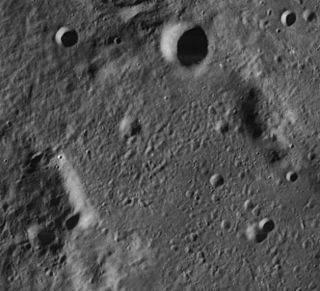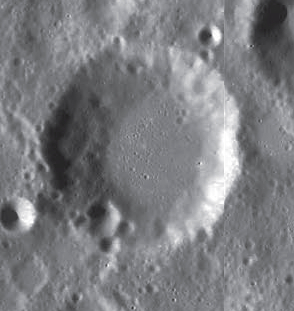
Anaximander is a lunar impact crater that is located near the northwest limb of the Moon. It is joined at the northern rim by the crater Carpenter, a younger and better-defined formation. To the southeast is the much larger J. Herschel, a formation of the variety known as a walled plain.

Meton is a compound formation on the Moon that consists of several merged crater rings that have been flooded with lava, forming the remnant of a walled plain in the shape of a clover leaf. It is located near the northern lunar limb, and is viewed from a low angle and foreshortened. The crater Barrow is attached to the southwest rim. To the northwest is the crater Scoresby, and to the east are Baillaud and Euctemon.

Ashbrook is a large lunar impact crater that is located in the vicinity of the south pole on the far side of the Moon, and so cannot be viewed directly from the Earth. The eastern face of the crater has been overlain by the similar-sized Drygalski, and more than half the interior floor of Ashbrook is covered by the outer ramparts and ejecta of Drygalski. To the northwest is the walled plain Zeeman.

W. Bond is an irregularly shaped lunar walled plain that is located in the northern part of the Moon, to the north of the Mare Frigoris. It lies to the east of the crater Birmingham, and south-southwest of Barrow. Epigenes is located just to the northwest of the outer rim. Along the southwest edge, between W. Bond and the lunar mare, is the crater Timaeus.

Birkhoff is a giant lunar walled plain that is located on the far side of the Moon, in the northern hemisphere. This formation is an ancient impact site that has been heavily eroded, and the surface reshaped by multiple craters in the interior and along the rim. The outer wall is bordered by the craters Carnot to the south, Rowland along the west rim, and Stebbins to the north. Just to the northeast is van't Hoff.

Baldet is a lunar impact crater that is located on the southern hemisphere on the far side of the Moon. It lies in the lava-flooded region between the craters Cori to the north, Stoney to the southwest, and the worn walled plain Minkowski to the southeast.

Banachiewicz is a largely degraded lunar impact crater that is located near the eastern limb of the Moon.

Birkeland is a lunar impact crater that lies in the southern hemisphere on the far side of the Moon. This crater is attached to the central waist of the oddly shaped Van de Graaff crater formation, and may partly account for that crater's figure-8 shape. To the southeast is the large walled plain Leibnitz.

Brunner is a lunar impact crater that is located along the eastern limb of the Moon, to the southeast of the Mare Smythii. At this location the crater is viewed from the edge, and so it is not possible to see much detail from the Earth. The visibility of this formation is also affected by libration. The crater lies to the southwest of the walled plain Hirayama, and to the east of the elongated crater Houtermans.

South is a large lunar impact crater that is located in the northwest part of the Moon. Most of the southern wall of this crater is joined to the Sinus Roris bay of the Oceanus Procellarum, with the southeast rim facing Mare Frigoris. Attached to the northwest of the formation is the larger walled plain Babbage. Just to the northeast is the crater Robinson, and farther to the northeast is another walled plain, J. Herschel.

Demonax is a lunar impact crater near the southern limb of the Moon. This location makes the crater difficult to observe due to foreshortening. The crater is also illuminated at a very low angle, when it is in the sunlit side. Demonax lies just to the north of the crater Scott, one of the south polar formations. To the north-northwest is Boguslawsky.

De Forest is a lunar impact crater on the far side of the Moon. It is located in the far southern hemisphere, to the west of the large walled plain Zeeman and due south of the crater Numerov. Because of its proximity to the southern pole, this crater receives sunlight at an oblique angle when it is on the illuminated half of the Moon.

Epigenes is a lunar impact crater that is located in the north part of the Moon, and is sufficiently close to the northern limb to appear significantly foreshortened from the Earth. It lies just to the northwest of the remains of the walled plain W. Bond. Due north of Epigenes is Goldschmidt, and the ruined crater Birmingham lies just to the southwest.

Davisson is a lunar impact crater that is located on the far side of the Moon from the Earth. This crater lies across the eastern rim of the huge walled plain Leibnitz, and the rim and outer rampart intrudes into the interior floor of Leibnitz. To the east-northeast of Davisson is the walled plain Oppenheimer, a formation only somewhat smaller than Leibnitz.

Poczobutt is a large lunar impact crater that is located on the far side of the Moon, just beyond the northwestern limb in an area occasionally brought into sight due to libration effects. This is a damaged formation that is partly overlain by several named craters. Across the rim to the north-northeast is the crater Smoluchowski. The crater Zsigmondy overlies the northeastern rim, and Omar Khayyam is located in the western part of Poczobutt's interior.

Chapman is a lunar impact crater that lies just beyond the northwest rim of the Moon, on the far side as seen from the Earth. It lies to the northeast of the crater Rynin, and southward of the large walled plain Poczobutt.
Cooper is a lunar impact crater that is located in the northern hemisphere on the far side of the Moon. It lies to the east of the large walled plain D'Alembert, and west-southwest of the crater Chappell.
Piazzi is an impact crater that is located near the southwestern limb of the Moon, and is attached to the southeastern rim of the walled plain Lagrange. About three crater diameters to the south is the crater Inghirami. Piazzi is seen at an oblique angle from the Earth, and it appears oblong due to foreshortening.

Dufay is a lunar impact crater that is located on the far side of the Moon. It lies about one crater diameter to the east of the large walled plain Mandel'shtam. To the northwest is the crater Papaleksi and to the east is Valier.

Laue is a lunar impact crater that lies across the south-southwestern rim and interior floor of the huge walled plain Lorentz. This feature is located on the Moon's far side, just beyond the west-northwestern limb. Under conditions of favorable libration and illumination from the Sun, this area can be seen at a very oblique angle from the Earth.






















